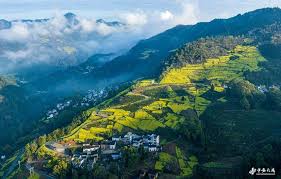Old industrial town becomes tourist magnet

Chongqing— Once a bustling industrial town, the Dawo residential community has endured the impact of environmental degradation and factory closures in recent decades.
Today, this residential community nestled in the towering mountains in Fengjie county, Chongqing, has morphed into a countryside tourist attraction thanks to its scenic beauty and industrial heritage.
The transformation began in 2015 when officials of the residential community, confronted with desolate land and a dwindling population, decided that pursuing a sustainable industry was the right direction.
The community used to be the seat of a State-owned sulfur factory founded in 1951, with a peak annual output of over 7,000 metric tons. The factory’s affiliated schools, hospital and cinema had once created a prosperous, self-sufficient town.

In 1998, the sulfur factory was transformed into a coal mine, extracting a total of 1.7 million tons of coal before being shut down in 2015, marking the end of Dawo’s industrial glory.
Following the closure of the factory, many workers who had lost their jobs moved out of the sluggish community to seek employment. Meanwhile, signs of environmental devastation due to years of excessive mining were evident everywhere. The land was acidified by sulfur, the core area of the factory turned barren, and farmlands were desertified.
“When it rained, water streamed down the slope with mud, sometimes flowing into houses,” said Luo Yifu, a former employee of the sulfur factory, recounting the magnitude of water erosion.
It took a decade for Dawo to reforest the land. About 266.67 hectares of cypress and larch have been planted in barren mountains. Leveraging its high-altitude location and ample sunshine, the community has cultivated about 166 hectares of soft-seeded pomegranates and crisp plums. These efforts have raised the forest coverage rate to about 90 percent.
Recognizing Dawo’s tourism potential with its canyons, caves and nostalgia-inducing industrial heritage from the old sulfur factory, local officials and residents have developed a tourist attraction featuring scenic spots, an industrial-themed cultural zone and opportunities for extreme sports.
The entire tourist area, covering 17.6 square kilometers, can receive up to 300,000 tourists annually.
As visitors step onto Dawo community square, they’ll be greeted with decorations evoking the area’s industrial heritage, such as a giant “love” logo crafted from a retired coal-transporting railway track, streetlamps mounted on abandoned coal stoves and other scenes. In the distance, out-of-use workshops, office buildings and blast furnaces add to the nostalgic atmosphere.
“We’ve repurposed the dilapidated factories and abandoned facilities into tourism attractions, preserving the memories of generations of mine employees while also drawing visitors,” said Wen Jinping, the Party secretary of Dawo who also worked at the sulfur factory.
Dawo’s tourism industry has created over 200 jobs, generating an annual revenue exceeding 7 million yuan ($985,000).
The burgeoning tourism sector has improved the living standards of residents. Song Guangxun, 55, a former employee at the sulfur factory, has been running a grocery store in the community since the factory closure. The influx of tourists in recent years has boosted Song’s business and afforded him extra income to renovate his house and support his child financially throughout college.
Luo Liangshun, a long-haul truck driver, returned to the community and started a farm-stay business that receives up to over 400 diners daily in the peak season. Last year, his venture yielded a revenue of over 720,000 yuan.
The transformation of Dawo is a microcosm of the green development of Fengjie county, where the eco-economy accounts for over 70 percent of the county’s total GDP.





